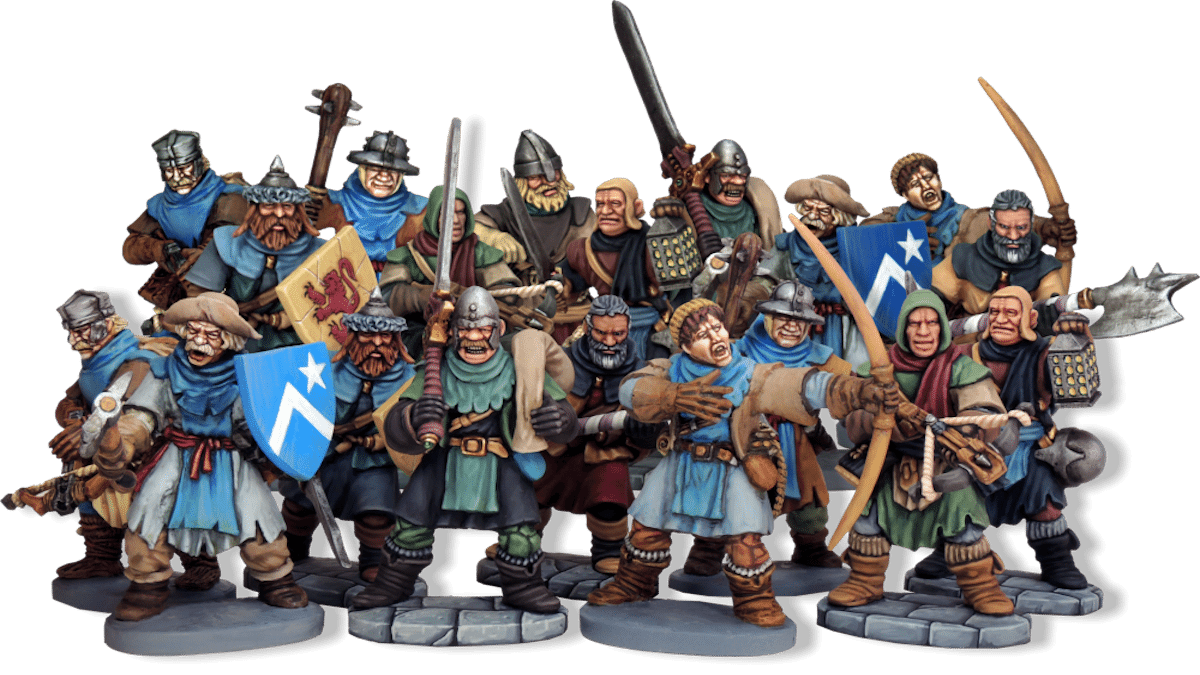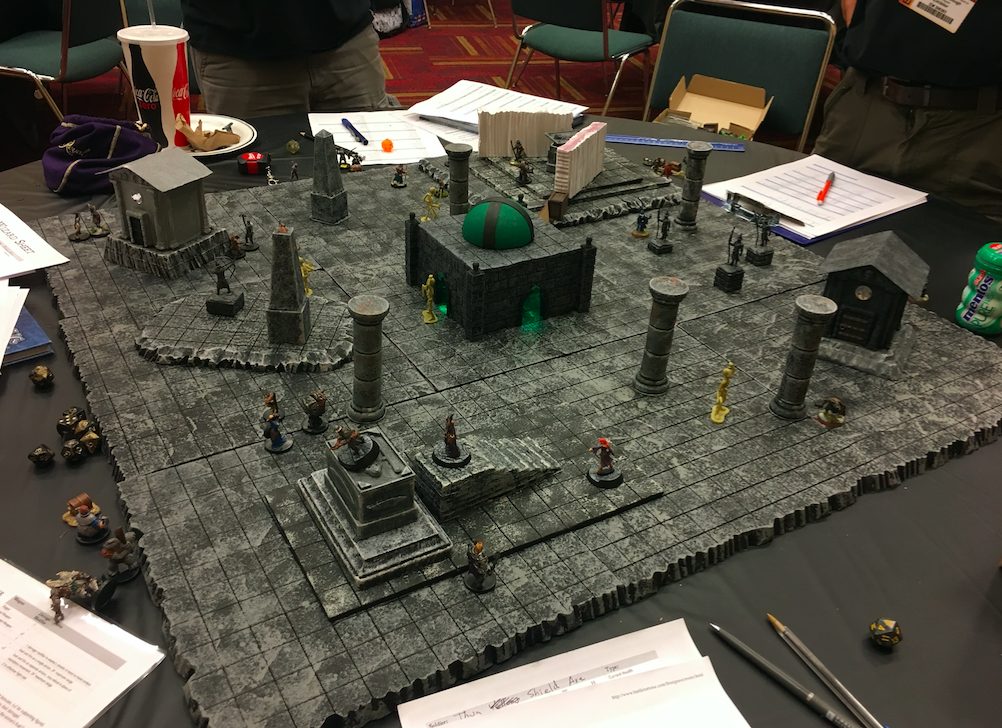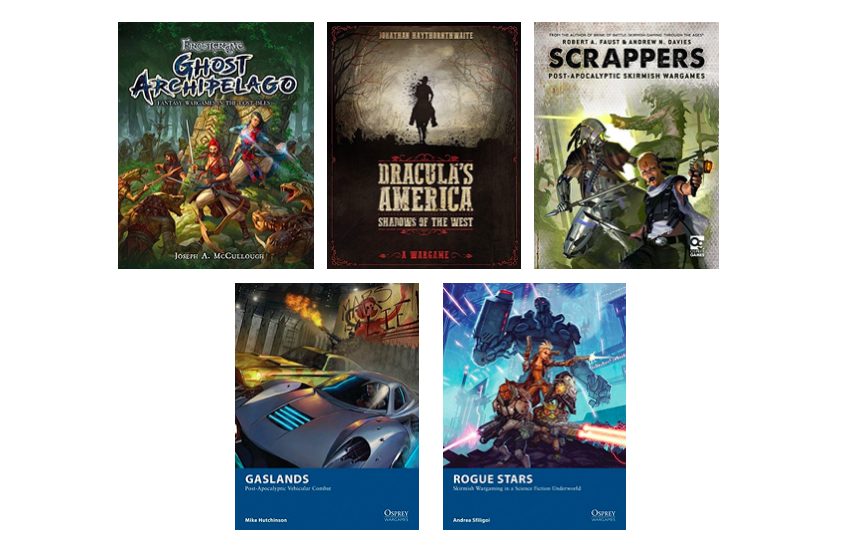I’ve been fascinated with wargames almost my entire life. I saw a large table covered with sand and hundreds of hand-painted metal miniatures when I was a kid, and that image has stuck with me for decades. I watched a group of men move around large blocks of soldiers and then roll dice and argue over distances and whether or not this group or that group of painted soldiers were tired or scared. I saw the table covered with miniature houses and trees and a lake (possibly a river), and I wanted to play. I was told the rules were too complicated. I was told to look but not touch. And I never got to play.
Decades went by before I would get my chance to play a wargame, but once I did… I was hooked. And now I have my own kids. Thankfully, there’s a type of wargame that isn’t too complicated for them to play. They can touch the miniatures and the houses and trees and move them all around. They will get to play.
This type of wargame is called a skirmish wargame, and since I’ve introduced my boys to this style of play I’ve discovered some real benefits that I’d like to share with you. I welcome your opinions in the comments below.
1. Put the Electronics Away
Electronics can often turn into a runaway train. Your kids start out with one hour a day, but then they finish homework or it’s raining outside or they’re sick in bed or… you get the idea. There are always reasons to give your kids just a little more time, and all of a sudden they’re playing those digital devices for 2+ hours a day. There’s no doubt why kids love the digital experience with its instant gratifications — You’ve Leveled Up! Achievement! You Have a New Power! Games are fun, and digital games always provide an opponent, especially when Mom or Dad or Big Sister are busy.
A good skirmish wargame can provide that bit of competition that a kid enjoys, including the advancements that make long-term game playing so fun. A typical skirmish wargame can also be finished in under two hours, so you’re not trading four hours of digital gaming for four hours of tabletop gaming. You’ll also find that most skirmish games have zero digital requirements — you’ll need dice, a manual/rulebook, and some miniatures. A few skirmish wargames can be played solo; most will need at least two players, but this is a small price to pay as a parent for reducing digital device time (as well as receiving the nine remaining benefits below).
2. Lower Investment to Play
The differences between a standard wargame (such as Warhammer 40K) and a skirmish wargame (such as Shadespire) are many, but for parents looking to start playing a tabletop wargame with their kids there is one key difference that parents are sure to appreciate — a low entry-level cost.
Traditional wargames often require a major investment — hundreds and even thousands of dollars are spent on armies and dice and books and terrain. This money is often spent over time as a player finds a game he/she enjoys and wishes to continue playing, but the fact remains that a traditional wargame can mean a significant investment where army sizes can push 50+ or even 100+ miniatures, official rulebooks can number in the dozens, and terrain is needed for covering a 4′ x 6′ or larger table surface. This isn’t the case with skirmish wargames that are designed to be played with small-scale armies (typically under 20 miniatures in total), require a single rulebook (although expansion books are available for popular games), and usually need a smaller amount of space (4′ x 4′ or less) to play.
This isn’t to say that costs can’t soar after you or your child finds a skirmish wargame you enjoy. It’s not unheard of for skirmish wargame players to buy more miniatures, more terrain, and other accessories, but this is typically after paying a small entry-level fee to try a skirmish game first. Not knowing if you or your child will enjoy a certain skirmish wargame, it’s nice to know that a skirmish wargame rulebook and some miniatures can often be had for around $50.
Example Traditional Wargame vs. Skirmish Wargame
Warhammer 40K Starter Box: $135 – 53 miniatures, 280-page rulebook, two supplemental books, and more
vs
Shadespire: $51 — 8 minatures (for 2 players), 32-page rulebook, gameboard
Update: If you’d like more details about Shadespire, fellow Geekdad , Robin Brooks has a YouTube Channel devoted to it. Click here to read some of Robin’s Geekdad posts on Shadespire.
3. Wide Range of Themes
Ten years ago, you would have had a hard time finding an inexpensive wargame to play with your child, let alone a game that might be of interest to both of you. Today, however, there are dozens and dozens of skirmish wargames that cover a wide range of themes. Want a game with wizards and warriors? Try Frostgrave. Is Star Wars a big deal in your house? Then Star Wars X-Wing Miniatures will be a huge hit. Got a kid that’s into zombies? Try The Walking Dead: All Out War. Or maybe your child likes explosions and has a large collection of Hot Wheels and Matchbox cars — try Gaslands.
There are skirmish wargames with historical themes (WWI, WWII, Vietnam, etc.), science fiction, fantasy, and more. If you and your child have a specific interest, a Google search will likely find you a rulebook. (You’ll also discover an amazingly large number of How-to-Play videos on YouTube that can give you an idea of gameplay before you buy.)
You should also be aware that many rulebooks can be adjusted or tailored to suit a theme. Players have taken the Frostgrave rulebook and converted it to rules for running a Star Wars campaign. The Dracula’s America rulebook provides rules for both a basic Western skirmish wargame and a supernatural-western themed game. The Black Ops rules can be adjusted for different timelines — World War II, Cold War, modern day, and even future spec-ops battlefields.
4. The Social Experience
Video games do have a social component if you’re talking about multiplayer, but let’s be honest… facing down an anonymous opponent won’t offer near the same satisfaction to your child as whooping Mom or Dad face-to-face. Parental defeat notwithstanding, there are other benefits to face-to-face game playing.
Developing good sportsmanship (plus seeing the negatives of bad sportsmanship) is an obvious one; players often shake hands before and after a game, and winning AND losing graciously is a skill that all ages should develop. Good speaking skills have benefits from debating a rule to explaining one’s decisions, and parents will miss an opportunity if they don’t encourage a young player to speak up during a game at home or away.
Unlike more complex wargames, skirmish wargames also have shorter spans of downtime. With more complex games, one player’s turn can take 5 or 10 minutes depending on the size of an army and the amount of moves and combat actions that are taken. Skirmish wargames typically run faster, with fewer moves and dice rolls for each player. During that downtime, however, young players can watch and listen and participate in some fun discussions. Playing a wargame is fun, and discussion topics will often divert away from game rules. For a parent player, your child’s downtime is a great time to ask about school, friends, concerns, and other topics as you take your turn… just be sure to listen.
Finally, skirmish wargames can be fun for kids to play with other kids. It can be tough for a gamer-parent to have to take a step back from the gaming table, but when a child wants to introduce a game to a friend… let the kids play. Let your child explain the game and rules to a novice. Let the kids enjoy surprise successes after risky moves. Let them debate rules (but help settle things if they are heading towards an ugly argument). Provide drinks and snacks, and once or twice a game poke your head in and let them catch you up on the game.
5. Encourages Creative Skills
Playing a skirmish wargame opens up all sorts of opportunities for kids to express their creativity. The most obvious is the assembly and painting of the game’s miniatures. Most wargame miniatures don’t come fully assembled and painted, but there are exceptions, notably Star Wars X-Wing Miniatures. Most miniatures come unassembled on sprues — these are the plastic frames that hold the molded parts such as torsos, weapons, and heads that must be cut from the sprues. (For younger kids, parents will need to help with the cutting.)
After cutting off the parts, your or your child can decide on poses and weapons. Many miniatures come with different arms, for example. Do you glue on the raised arm or the bent arm? Do you glue in a sword or an axe or a maybe a bow? Should you glue the head looking forward or to the right? Kids will have their own ideas for how they wish their small army to look, and you should let them customize their armies to their liking.
The same goes with painting. Most miniatures come unpainted, and many wargame players absolutely love further customizing their small army with a unique color scheme. If your child wants his wizard to wear a lime-green robe, what’s the harm? Does she want a 100% black robot? Go for it! Buy a small collection of miniature paints (avoid the thicker craft acrylics as they usually need to be watered down heavily for proper coverage) and a few brushes and tuck them into a small shoebox with your child’s name on it. Pick up a can of white or black primer spray paint and you and your child are in business.
UPDATE: Apparently some folks didn’t understand my warning about acrylics. I am speaking of the thicker craft acrylics that have to be watered down, not the miniature paints that are also, yes, acrylics.
Some Starter Miniature Sets and Paints
Reaper Learn to Paint Kit – $32 – 11 bottles of paint, 2 brushes, 3 practice minis, instruction book
The Army Painter Starter Paint Set – $31 – 9 bottles of paint, 1 brush, 1 bottle of wash
Citadel Base Paint Set – $41 – 11 pots of paint, 1 brush
6. Rulebook Reading Required
Parents with young kids who love to read are lucky, aren’t they? The rest of us must deal with the fussing and fighting that comes from trying to get a child to sit and read for just half an hour… sometimes less. Some of us resort to comic books and graphic novels — anything to get them reading, right?
When it comes to skirmish wargames, parents with reluctant readers may be in luck. The trick is to find a game that really grabs your child’s attention. Maybe it’s the box or the rulebook cover, but once you find a skirmish wargame that interests your child, it’s time for a little pre-planning and work. There’s no need to make them read the rulebook from the start; that’s your job as parent. Read the rules, set up the table for a quick game, and play. It may take more than one game… but hopefully your child will have fun AND want to play again. Do try and keep the games simple and not use any optional or advanced rules. Likewise, if you can limit types of playable elements (such as weapons or type of soldier), do so… leaving some surprises in the rulebook.
Does your child want to play again? If so, it’s time for him or her to read the book. One of the best things about most skirmish wargames is the shorter rulebook. Some rulebooks are extremely short and sweet — Fat Dragon Games’ World War Tesla rulebook is a mere 14 pages — but most are less than 64 pages and come with plenty of artwork and photos. You’ll want to stress to your child that the rulebook contains many more options that will enhance future games. Mention in-game items such as weapons or spells that have yet to be used as well as optional and advanced rules. Hopefully this ‘secret’ knowledge that only you (as parent) know may spur your resistant reader to sit down and dig in.
7. Some Math Involved
Don’t worry — it’s not Algebra or Calculus. (Although there are wargamers who get really deep into the math of a game, optimizing damage and speed and other factors related to an army.) When it comes to skirmish wargames, the math involved is typically addition and subtraction. Easy stuff, sure, but for younger game players, this can be a great way to sneak some math into their fun time.
What’s really interesting is when you see a young gamer start ‘crunching’ numbers to maximize something such as damage or movement speed. There are often balances in a wargame where players will need to do some A/B analysis in their heads. Do I increase my soldier’s movement distance to reduce my opponent’s chance of hitting him? Increasing movement distance means no second action, however, and I won’t be able to take a shot at my opponent’s tank. Or do I stay put, increase the chances of my soldier getting hit, but get two chances to fire at the tank?
Many skirmish wargames allow each player a certain number of points or gold or cash to spend on soldiers and weapons, for example. This also requires some balancing and ‘what if?’ scenarios, often with a little math involved. Pay 150 for the single weapon or apply that to 3x more armor for my helicopter?
Young players will also soon enough figure out how to calculate odds in their heads. Whether they understand percentages or not, they will start to see that they are more likely to roll a 15 or lower on a d20 (20-sided die) than a 10 or lower. As things improve, they’ll even be able to start doing the math with different dice — I need to roll a 1, 2, or 3 on a d6 (6-sided die) but my opponent only has to roll a 1-8 on a d12. They may not know that it’s 50% vs 66%, but they’ll somehow know they have a lesser chance of success.
One additional benefit to all types of wargames is learning to measure. It doesn’t matter whether you use centimeters or inches, moving miniatures around on the table will require young players to read a ruler and measure distances. A minor benefit, yes, but a skill that most adults take for granted and often forget that young players need to practice.
8. Increases Motor and Critical Thinking Skills
This one is paired with painting miniatures, but it also applies to the creation of terrain. Holding a paintbrush and applying a small dot of paint on some buttons or a carefully painting a bronze rim around a shield is hard at first… but it does become easier. Kids are their own best critics, and they’ll know when their painting skills are improving.
Gamer parents are also likely to see some solid jumps in their children’s reasoning and logical skills. Critical thinking is a skill that we hear a lot about, so much so that it begins to sound like a buzzword. But with young wargamers, the complexity of a skirmish wargame will have them looking at the entire tabletop, evaluating decisions and planning strategies that will keep those neurons firing and building more connections.
Many skirmish wargames offer up scenarios; these are variations of the ‘basic game,’ and usually have special rules that are added to the basic rules that define certain conditions that must occur for a winner to be determined. Scenarios also sometimes have a story that sets up the action, and parents can give their young player the details of the scenario a day or two in advance of the game. This allows the young player to ponder and develop different strategies before any miniatures are placed or dice rolled.
The key is find the right game with the correct level of complexity for a young gamer. Unpainted minis will test the motor skills, and a good ruleset will offer up enough variability to allow a young player’s brain plenty of room to explore options, pose ‘what if?’ situations, and envision strategies for success.
9. High Risk Attempts, Low Stress Failures
It’s a fact of life that kids will fail at things — school tests and sports come to mind. Kids will deal with failure and stress differently, just like adults… but adults are supposed to have better coping skills that come with experience and age. The last thing a parent will want for their child is for stress from failure to come from a simple tabletop game.
With traditional wargames, the stakes are higher — the number of miniatures on the table is greater, the rules are usually more complex, and pre-planning can take as long or longer than the played game itself. There is definitely a much larger investment in time and materials, and this can make the loss of a game feel more personal. For this reason, the faster and lower-cash-and-time-investment skirmish wargames offer a less significant loss (or win) when compared to more traditional wargames.
Skirmish wargames still have a winner and loser, but with simpler rules and fewer miniatures on the table, games are faster. Faster games also tend to balance the odds when it comes to new players; because there are fewer rules and options, more experienced players are less likely to pull out surprise tactics that feel unfair to a new player. Simpler rules can also mean that the results of dice rolls are based less on skill and more on luck.
The gameplay in skirmish wargames lends itself to experimentation; taking a chance in a one-hour wargame feels more risky than it does with a 3+ hour wargame, but a failed attempt can lose much of its sting when a young player sees a (likely) similar failure by his or her opponent during the game. With a longer game, a more experienced player can spread out losses, but with a short skirmish game, risks and results should be somewhat equal between all players. In a fast game, a young player should have just as many good rolls as bad, meaning that kids will experience a balance of highs and lows rather than a string of constant losses.
10. More Family Time
Playing games with your child requires your attention. There are the rules of the game that must be followed, but there’s also the act of ‘being there.’ It’s too easy to hand a child a phone or tablet and let them go sit down and play a game by themselves. A 2+ player game requires a commitment from all players, and when it’s a parent vs. child, that commitment should be 100% no distractions. Put away the cell phone. Turn off the TV. Close the laptop.
\Whether you play once a week or once a month, a skirmish wargame is time together. Yes, there are plenty of other activities you can do together… and you should do as many as possible. Many of them are just as likely to offer the same benefits listed above.
But if you’re a gamer-parent with a child who loves games…
if you want to move beyond LIFE and Monopoly…
and if you want something non-digital and engaging…
set out some minis and dice on your table alongside a rulebook and show them a new type of game to play.






Just a point of clarification: the paints that you want for miniatures ARE acrylic. Craft paints can be used inexpensively, but there are many good lines of hobbyist paints especially for miniatures.
Good point. I guess I was referring to the thicker craft acrylics.
This was a post I did on the Two Hour Wargames website long ago for the All Things Zombie (skirmish game). This is exactly what this hobby is all about!
The first time a new kid comes to game (with his friend’s family. A zombie game table set up).
What? There’s no screen? How do you… You mean I have to face my opponent and even have to talk to them. (You got a nice house here.)
Heh…. What’s that? Dice? How quaint. (Sure, I’ll take a Coke.)
Cool little figures. You know, I’ve heard about army men from movies… YOU PAINT THEM YOURSELF?! (You do a good job, I could never do that.) Nice dollhouses.
Hey, can I bring my Hot Wheels?
No No Go left! I think we should run through the house. (Yea, my teacher said the same thing in my class. Who do you have?)
Cool, I want to loot the body… YAY! I got a shotgun. (I’d say the scene with Shelob was the scariest.)
Wow, I almost died. Thanks for saving me. Why are you laughing? No, You can’t have my shotgun. I guess with that pistol aimed at my face, you are going to get that shotgun. Just watch your back. (Well, my favorite show is in an hour, but I can record it. No, I’ll stay.)
How come we shoot the zombies up and we always get more and Jake is beating them with a baseball bat and he gets none? (Stop throwing popcorn at me…Steve…[giggle]…Don’t do it Steve… [giggle-haahaaa])
Is that a grenade? ooooHH, I’ll take that.
How did I know you were in the explosion’s spread…. Do I have enough room to scoot over and pick up the shotgun from his mangled body? How many more zombies did that bring in? (You got great parents. I didn’t know you could play this with them.)
Awesome. I just became zombie chow!
Well, that was cool! er… do you… when do you play this again? (You guys are cool to hang around with.)
Can I get one of those miniatures with a shotgun. I love shotguns! Can you paint it for me? You’ll show me how to paint it? Cool!
[What really happens to youth when they venture forth from Video Games and get sucked into the dark vortex of wargaming. ] : )
I like this! Thanks for sharing it.
Today’s kids are digital in their blood, though, so don’t deny them the skills and immersion they’ll need for succeeding when they’re in their 20s and 30s.
Play both, and don’t forget to have them ride bikes and go camping/to the beach, etc.
I was going to try to get my daughter into D&D about a year ago, but trying to get started it was a bit too clunky for her and especially as a pen and paper RPG it lacks the visual element that can interest a young mind. I’m looking forward to trying some stuff with miniatures with my kids. After doing a bit of research I think I’m going to try either Wings of Glory or Battletech Alpha Strike.
Good article. Been a table top gamer over 40 years. Introduced my sons and now my grandsons to the hobby. Taught an after-school program in two local middle schools for years. Even ran a game room/hobby shop for a while. Computers are here to stay but in my experience, the skills and experience mentioned here are far more essential to genuine success than ‘digital immersion’.
Great article! I’m just discovering the joy that is Osprey Wargames and I can’t wait to try them with my kids. I’m customizing some Hotwheels for Gaslands (putting those extra 40k bits to good use) and I have printed out and glued up about 50 paper minis for Ronin. Paper mini’s drop the cost even more, even if the tabletop looks a bit less dramatic.